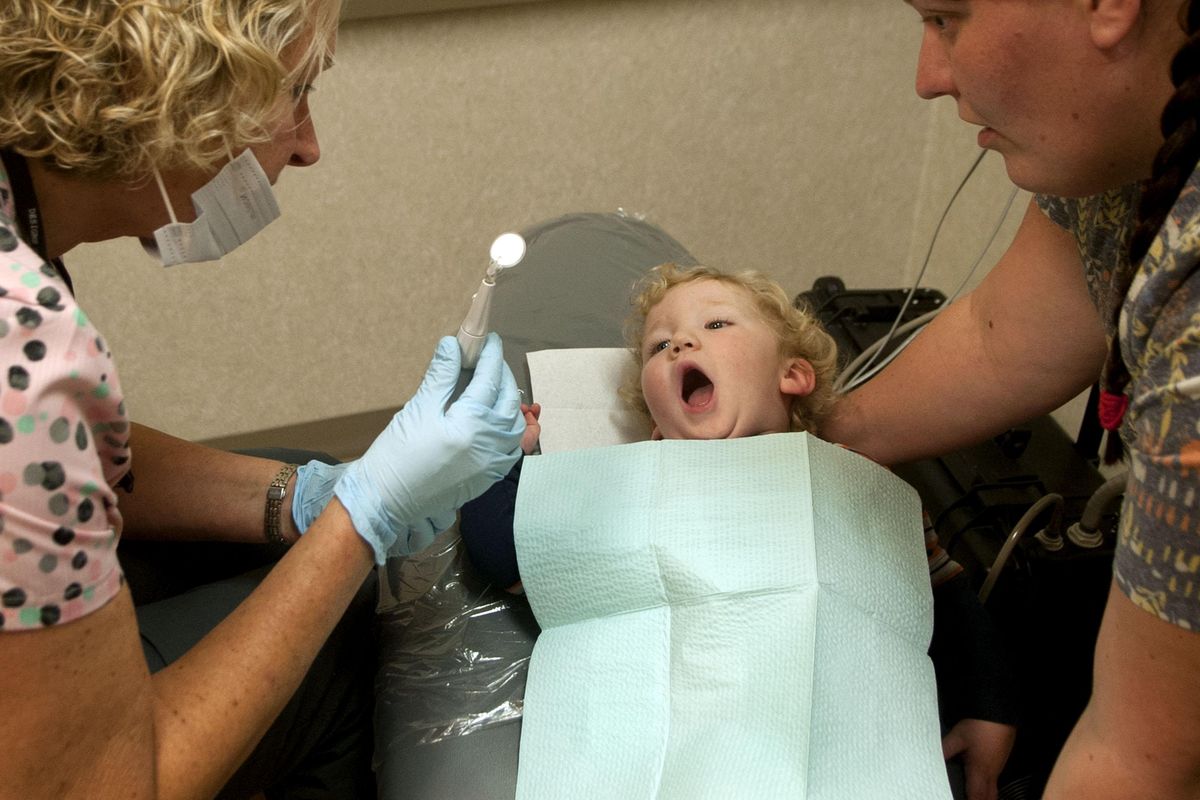Panhandle Health District fills gap in dental care for North Idaho kids

HAYDEN, Idaho – Carrie Busch is in the business of making going to the dentist a less scary thing for families and kids, especially when she is the first dental hygienist they have ever seen.
Busch works with the Panhandle Health District to offer dental cleaning and care to low-income children and pregnant mothers in the five northern Idaho counties.
This month, she took a trip to St. Maries, where she packed a portable chair, a compressor with cleaning equipment and a cart with supplies into the health district Subaru and drove to the district office 60 miles south.
She saw two brothers, ages 8 and 10, who had never had their teeth checked. She took it slow, working away at the tartar buildup, and she was able to talk to them about the importance of brushing their teeth, she said. The 10-year-old was close to having his adult teeth grow in, and she talked to him about what that meant for his long-term health.
“It made it worth the trip just for those two kids, because they had never been seen before,” Busch said.
If she is not seeing patients for the first time, she is often seeing kids in families who struggle to schedule an appointment with a dentist that takes Medicaid. Families are sometimes put on waitlists at dentist offices that do accept Medicaid.
“It’s like a broken record I hear so often,” Busch said.
The Panhandle Health District is helping fill the gap for uninsured and Medicaid-insured children in the region.
In the past year, the district started a monthly program called Dental Days, opening their Hayden clinic to appointments for Medicaid or uninsured children, as well as pregnant mothers, all day until 7 p.m. The health district separately sends their dental teams to low-income schools in the region throughout the school year.
On Wednesday, Busch had about 10 appointments with children and teenagers in the Hayden clinic.
The health district’s dental operation is functional and portable. This month, the health district expanded its Dental Days to outlying, rural offices in Bonners Ferry, Sandpoint, St. Maries and Kellogg.
The health district does have its limitations, however. There are two dental teams, each made up of one hygienist and one assistant, that put on clinics at low-income schools as well as at Dental Days. As a hygienist, Busch can clean teeth and identify issues like decay that might signal bigger problems, but she cannot do X-rays or fillings. She can make recommendations to patients or to the parents of the children she sees who need further care, but with the limited amount of Medicaid-accepting dentists in the region, it can be frustrating, she said.
Dentists who take Medicaid in the area are few and far between. Dentists are not required to take Medicaid if they are a private practice, and Busch, who has worked in private practice for 40 years, said there used to be more Medicaid providers in the Coeur d’Alene area.
Within 70 miles of Hayden, there are 31 dentists in 11 practices accepting new patients with Medicaid coverage in Idaho. Some Spokane and Spokane Valley providers will accept Idaho Medicaid, the Idaho online provider directory shows.
A search for pediatric dentists yields far fewer results. There are no pediatric dentists accepting new patients with Medicaid in Kootenai County. Instead, there are four out-of-county Idaho providers as well as four Spokane-area based pediatric dentists listed.
“It’s been a crisis here for so long,” Busch said.
The American Academy of Pediatric Dentistry recommends that children go to the dentist by age 1 or when their first teeth begin to emerge. But more than 13% of third-graders in North Idaho have no history of dental service, a 2017 survey found.
The state is in the process of expanding Medicaid, and enrollment began on Nov. 1. Benefits start on New Year’s Day. That will open up dental care access to thousands of Idahoans.
The Idaho Department of Health and Welfare estimates that 91,000 Idahoans will be eligible for coverage, and the state health insurance exchange, Your Health Idaho, estimates that 18,000 of their clients will roll over to Medicaid coverage. Under Medicaid expansion, Idahoans with income levels up to 138% of the federal poverty level will be eligible for Medicaid coverage. For example, a four-person household making $35,535 or less annually will be covered under Medicaid in 2020.
Previously, Idahoans who were between 100% and 138% of the federal poverty level could get a tax credit for their health care coverage purchased through the state benefit exchange. Those enrolled in plans at these income levels will automatically roll into Medicaid coverage in January.
In 2020, Idaho residents from 139% to 400% of the federal poverty level are now eligible for tax credits on health insurance coverage through Your Health Idaho. Enrollment for plans through the exchange runs through Dec. 16. The state exchange is prepared for the shift in clientele as the expansion rolls out, Executive Director Pat Kelly said.
“We’re able to weather that storm,” he said.
More Medicaid clients means a larger pool of people with access to dental coverage, and Busch hopes the health district will be able to expand its dental care and coverage to older clients in the future, especially with expansion on the immediate horizon. But she also hopes local providers will take on Medicaid clients.
“Hopefully some of them will open their hearts and their doors to the older population,” she said.